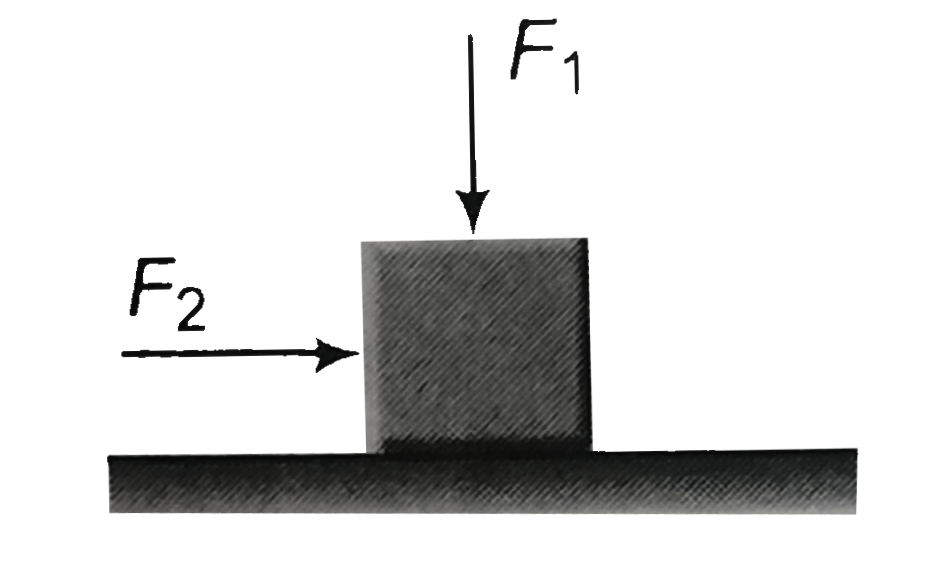Two forces of mangitude F1 and F2 are acting on an object.The magnitude of the net force Fnet on the object will be in the range.
F1≤Fnet≤F2
|F1−F2|/2≤Fnet≤(F1+F2)/2
|F1−F2|≤Fnet≤F1+F2
|F1−F2|≥Fnet|F1+F2|
The correct Answer is:C
To determine the range of the net force Fnet acting on an object due to two forces F1 and F2, we can use the principles of vector addition. Here’s the step-by-step solution:
Step 1: Understand Vector Addition
When two forces are acting on an object, the resultant or net force can be calculated using vector addition. The formula for the magnitude of the resultant force Fnet when two forces are acting at an angle θ to each other is given by:
Fnet=√F21+F22+2F1F2cosθ
Step 2: Determine Maximum Value
The maximum value of Fnet occurs when the two forces are in the same direction, which means cosθ=1. Therefore, the maximum net force can be calculated as:
Fmax=F1+F2
Step 3: Determine Minimum Value
The minimum value of Fnet occurs when the two forces are in opposite directions, which means cosθ=−1. Thus, the minimum net force can be calculated as:
Fmin=|F1−F2|
Step 4: Establish the Range
From the above calculations, we can establish that the magnitude of the net force Fnet will lie within the range:
|F1−F2|≤Fnet≤F1+F2
Conclusion
Thus, the magnitude of the net force Fnet on the object will be in the range:
Fmin≤Fnet≤Fmaxor|F1−F2|≤Fnet≤F1+F2
When two forces are acting on an object, the resultant or net force can be calculated using vector addition. The formula for the magnitude of the resultant force Fnet when two forces are acting at an angle θ to each other is given by:
Fnet=√F21+F22+2F1F2cosθ
The maximum value of Fnet occurs when the two forces are in the same direction, which means cosθ=1. Therefore, the maximum net force can be calculated as:
Fmax=F1+F2
The minimum value of Fnet occurs when the two forces are in opposite directions, which means cosθ=−1. Thus, the minimum net force can be calculated as:
Fmin=|F1−F2|
From the above calculations, we can establish that the magnitude of the net force Fnet will lie within the range:
|F1−F2|≤Fnet≤F1+F2
Thus, the magnitude of the net force Fnet on the object will be in the range:
Fmin≤Fnet≤Fmaxor|F1−F2|≤Fnet≤F1+F2
Similar Questions
Two forces F1 and F2 are acting on a rod abc as shown in figure.

View SolutionA block is kept at rest on a rought ground as shown. Two force F1and F2 are acting on it. If we increased either of the two force F1and F2, force of friction acting on the block will increase.
By increasing F1, normal reaction from ground will increase.

View Solution
Knowledge Check
If all of the forces acting on an object are balanced (net force is zero), then
Athe object must be at restBthe object's speed will decreaseCthe object will follow a parabolic trajectoryDthe object is experiencing zero acceleration
Two forces F1 and F2 are acting on a body. One force is double that of the other force and the resultant is equal to the greater force. Then the angle between the two forces is
View SolutionAssertion:− when two non parallel forces F1 and F2 act on a body. The magnitude of the resultant force acting on the is less than the sum of F1 and F2
Reason:− In a triangle, any side is less then the sum of the other two sides.
View SolutionTwo force F1 and F2 are acting on a body. One force is double that of the other force and the resultant is equal to the greater force. Then the angle between the two forces is :-
View SolutionTwo forces with equal magnitudes F act on a body and the magnitude of the resultant force is F /3. The angle between the two forces is
View SolutionTwo forces of magnitudes 3N and 4 N act together on an object making an angle 60∘ with each other. Find the resultant force acting on the object.
View SolutionTwo forces, each of magnitude F have a resultant of the same magnitude F. The angle between the two forces is
View SolutionTwo forces, each of magnitude F have a resultant of the same magnitude F. The angle between the two forces is
View Solution
